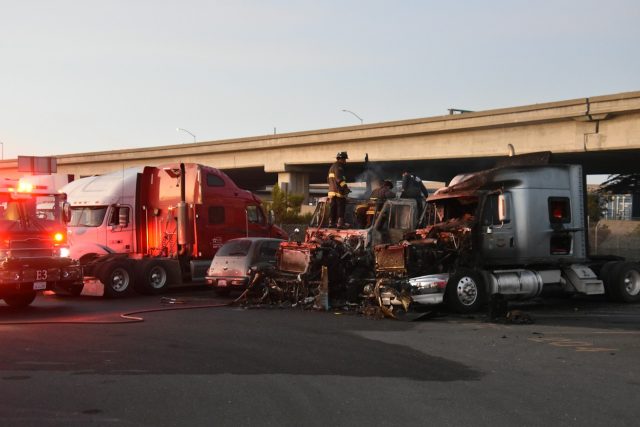
The aftermath of a multi-vehicle pile-up involving a commercial truck is a scene of pure chaos. Twisted metal, shattered glass, and the jarring silence that follows the final impact create a bewildering puzzle. For those injured, the immediate question of who is at fault seems impossibly complex. A common misconception is that liability simply rests with the last vehicle in a chain reaction or the one that made the most forceful impact. However, from a legal standpoint, the truth is rarely that simple. Determining responsibility in these catastrophic events is not about finding a single point of blame. It is a methodical process of untangling a complex chain of liability, tracing a series of decisions and actions that may have started miles away or even weeks before the crash, involving parties who were never physically at the scene.
The First Link: Driver Error and Company Negligence
The investigation into a commercial truck’s role in a pile-up almost always begins with the person behind the wheel. A driver’s error—whether caused by fatigue from violating federal hours-of-service rules, distraction from a mobile device, or excessive speed for the conditions—is often the triggering event. However, the liability chain rarely ends with the driver. In a vast number of cases, their mistakes are symptoms of a larger, systemic problem originating with their employer. This connection between the driver’s mistake and the company’s failure is often the core of a legal claim.
| Driver’s Action (Symptom) | Potential Company Negligence (Root Cause) |
| Driving while fatigued. | Pressuring drivers to violate hours-of-service rules. |
| A history of previous moving violations. | Failing to conduct a proper background check during hiring. |
| Inability to handle the truck in adverse conditions. | Providing inadequate training on vehicle safety. |
The trucking company can be held negligent for pressuring drivers to meet unrealistic deadlines, failing to conduct proper background checks, or providing inadequate training. Under a legal doctrine known as “respondeat superior,” employers are held responsible for the actions their employees take within the scope of their employment, firmly linking the company to the consequences of the driver’s conduct on the road.
Investigating Mechanical Failures and Maintenance Gaps
Sometimes, the primary fault lies not with the driver, but with the 18-wheeler itself. A catastrophic mechanical failure, such as a brake system collapse, a tire blowout from worn tread, or a steering component failure, can instantly turn a massive truck into an uncontrollable force. In these situations, the liability chain extends to those responsible for the vehicle’s upkeep. An investigation will often uncover a history of neglected maintenance, with companies cutting corners on repairs to keep trucks on the road. Liability may rest with the trucking company for ignoring safety protocols, or it could fall on a third-party maintenance facility that performed a shoddy repair. The investigative skills needed to connect a pattern of maintenance neglect to a catastrophic failure are highly specialized, whether the case involves a commercial vehicle or a different complex scenario handled by a casino accident lawyer who might investigate faulty equipment or security systems.
The Cargo Connection: Improper Loading and Shipper Liability
A truck’s trailer is not just a box on wheels; its contents can dramatically affect the vehicle’s stability and safety. When cargo is improperly loaded, unbalanced, or inadequately secured, it can shift during transit. This sudden change in the center of gravity can cause a driver to lose control, leading to a jackknife or rollover that triggers a multi-vehicle pile-up. Similarly, if a truck is overloaded beyond federal weight limits, its brakes are less effective, and the risk of failure increases exponentially. Liability for these incidents can extend beyond the trucking company to the party that loaded the trailer or even the original shipper of the goods.
Deconstructing the Crash Scene: The Role of Accident Reconstruction
To transform the chaos of a multi-vehicle pile-up into a clear, understandable sequence of events, legal teams rely on accident reconstruction experts. These specialists use a combination of physics, engineering, and advanced technology to create a scientific narrative of the crash. They meticulously analyze a wide range of physical and digital evidence, including:
- The length, pattern, and location of skid marks.
- The crush depth and profile of vehicle damage.
- The final resting positions of all vehicles and debris.
- Crucial data from the truck’s event data recorder, or “black box,” provides information on speed, braking, and steering inputs in the moments before the collision.
By integrating this data with witness statements and dashcam footage, reconstructionists can pinpoint the initial point of impact and demonstrate how a truck’s single action or failure set off the devastating chain reaction.
Assigning Fault Among Multiple Drivers
Even when a truck’s failure is the clear catalyst for a pile-up, the inquiry doesn’t end there. The actions of every other driver are scrutinized to determine if they share responsibility. This principle, known as comparative fault, assesses whether other motorists contributed to the crash or their injuries. For instance, a driver following too closely might be unable to stop in time, while a distracted driver may fail to react appropriately. In these complex situations, a court or insurance company apportions fault in percentages. A trucking company might be found 80% liable, while another motorist is assigned 20% of the blame. Henderson truck liability experts can help navigate this process to ensure liability is assigned fairly among all parties.
Conclusion
In conclusion, a multi-vehicle truck accident is a complex web of responsibilities, not just a chaotic mess of steel. True accountability is rarely found by blaming a single driver; instead, it’s discovered by examining every link in the liability chain—from the corporate boardroom to the driver’s seat. Each party’s decisions and failures contribute to the devastating outcome. For those injured, achieving justice and fair compensation depends on a thorough, expert-led investigation that can unravel this chain. Understanding that liability is a series of failures, not a single point, is the first step toward rebuilding a life shattered by a catastrophic, and often preventable, pile-up.










